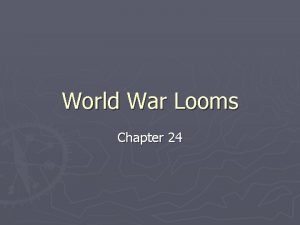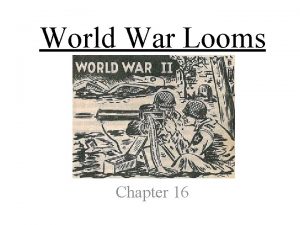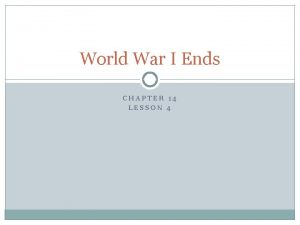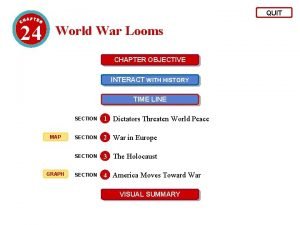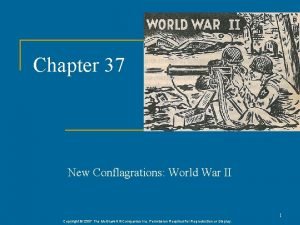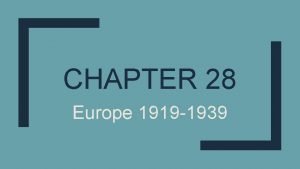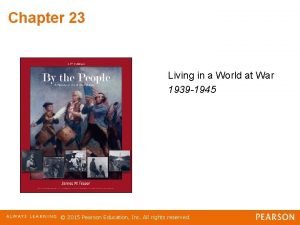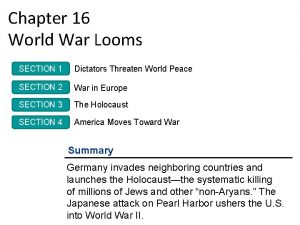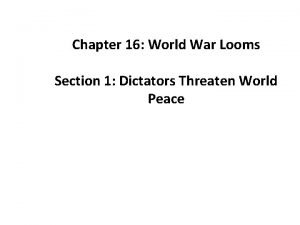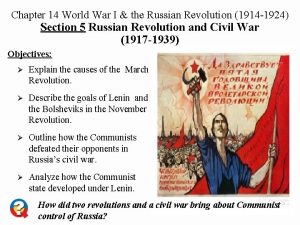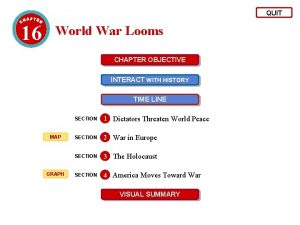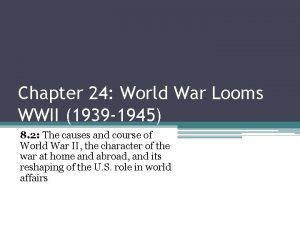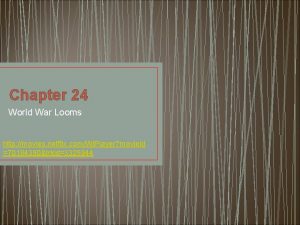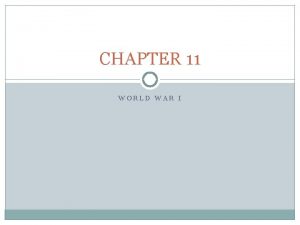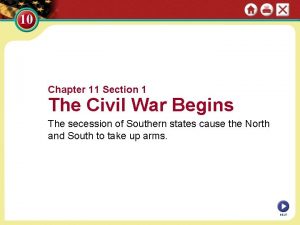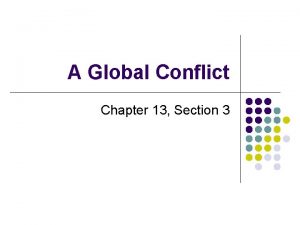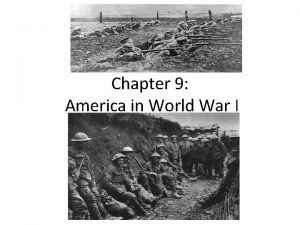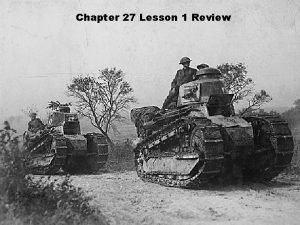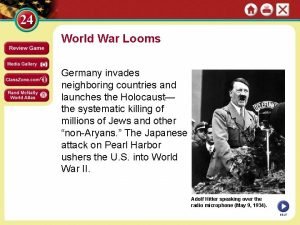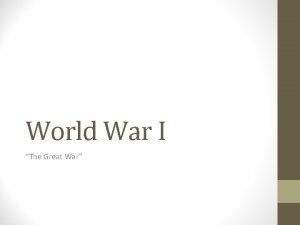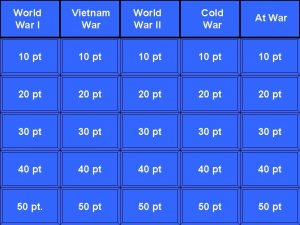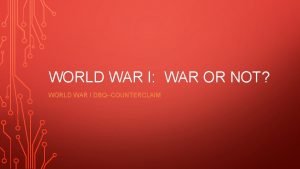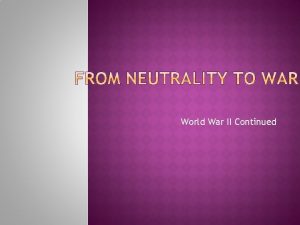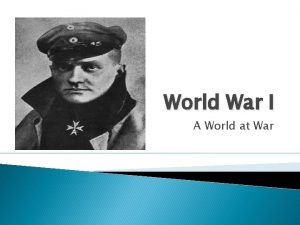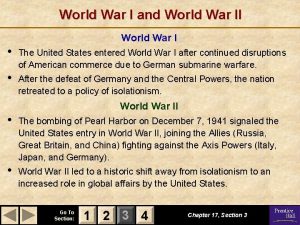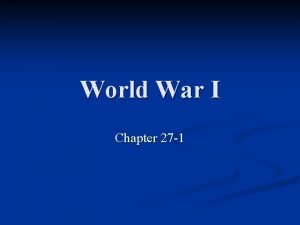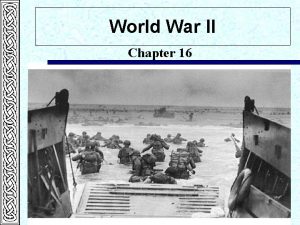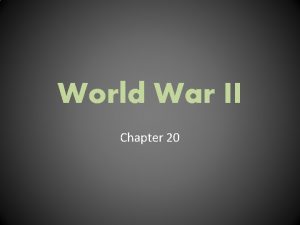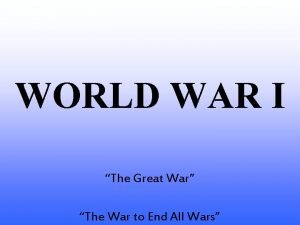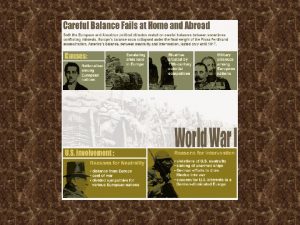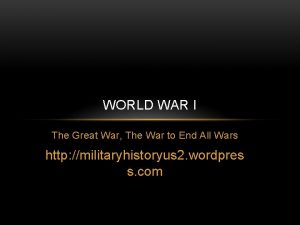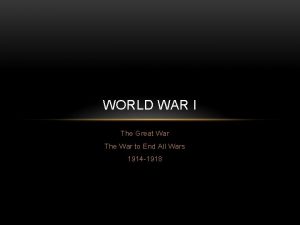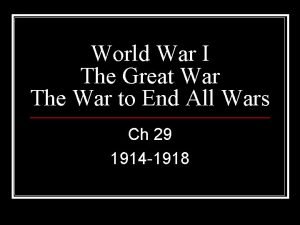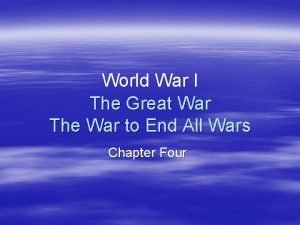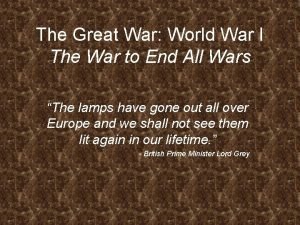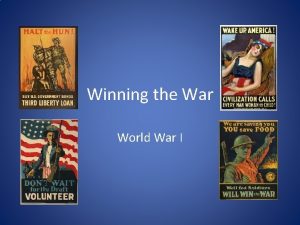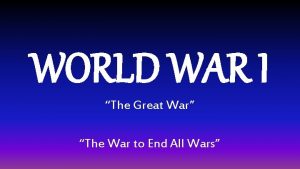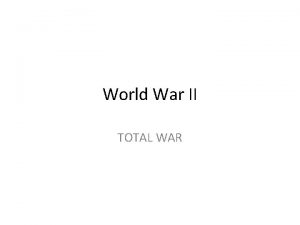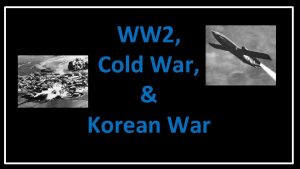World War II Chapter 16 World War II
































- Slides: 32

World War II Chapter 16 World War II

Paths to War: Germany & Japan Section 1 World War II

German Path to War • Hitler’s Idea: Aryan race & Germany would become a powerful country (large populations need more land, right? – How will Germany acquire more lebensraum? • Look to the EAST… • First Steps by Germany: – 1. Revise Treaty of Versailles by “peaceful” means. – 2. Built Air Force & military – 3. Reoccupy the Rhineland (demilitarized area) – 4. Appeasement – keep things peaceful in Britiain

New Alliances • Axis Powers – Italy – Japan – Germany • Hitler wanted to unite with Austria – Convinced Austria to put Nazis in charge of government & then Hitler annexed Austria as a part of Germany

Japanese Path to War • War with China – Japan wanted to expand into Chinese lands • New Asian Order – Japan wanted to help modernize the rest of Asia – Acquire Soviet Siberia (rich in resources) – Cooperated with Nazi Germany in plan to attack Soviet Union

Course of War Section 2 World War II

Germany Sparks a New War • Stalin and Hitler make a deal to reclaim land taken by Allies (Nonaggression Pact) • Germany invades Poland, France and Great Britain declare war on Germany September 1939. (Cannot mobilize troops) • Blitzkrieg “Lightning War” – new German war tactic • Stalin orders Russian troops to invade and occupy the western part of Poland

France Falls • Hitler launches an attack through Belgium, Luxembourg, and the Netherlands (side tracks France) • Germans made it through fortifications and into France, eventually took over Paris. • France surrendered June 22, 1940. • French resistance to German occupation set up a government in London to try to recapture France.

Battle of Britain • Winston Churchill – new British Prime Minister • Bombing Raids by German Luftwaffe (air force) • Two Technologies Helped British: – Radar Detection (# of planes and direction) – Enigma German code-making machine (to break code) • May 1941, Hitler called off attacks in Great Britain due to strong British resistance.

The Eastern Front • June 22, 1941 Hitler’s troops invade the Soviet Union (Russia). – Soviets not prepared for attack, WHY? • Soviets still used scorched earth policy (Who had this defeated before? ) • Germans siege Leningrad – 1 million people died in siege (Germans starved them to death and surrender) • Hitler’s order for no retreat when trying to take Moscow cost them 500, 000 lives when winter weather set in. (Sound familiar? )

Comprehension Check • 1. True or False: Hitler’s military tactic he used in WWII was called the Schlieffen plan. • 2. True or False: After Hitler invaded Poland, the United States declared war on Germany. • 3. True or False: At the beginning of the war, the United States remained neutral and did not join the war. • 4. True or False: Winston Churchill was the Prime Minister of France. • 5. True or False: Hitler made a costly mistake of invading the Soviet Union in 1941.

Japan’s Pacific Campaign Section 2 World War II

Pearl Harbor • December 7, 1941 – Attack on Pearl Harbor – First attack on American soil = declaration of war • Japanese Admiral, Isoroku Yamamoto said Pearl Harbor was a “dagger pointed at [Japan’s] throat” (a threat) & needs to be destroyed • U. S. knew attack was eminent, but did not know where • In 2 hours, Japanese had sunk 19 ships (8 battleships), 2, 300 Americans kiled/1, 100 wounded = SHOCK

Pearl Harbor

Allies Strike Back • Battle of Midway: 1, 500 miles west of Hawaii – Turning Point in War: Japan’s navy defeated • Douglas Mc. Arthur – general of U. S. troops in the Pacific – “Island Hopping” – trying to capture Japaneseheld islands

War Limits Civil Rights • Japanese Internment Camps – Japanese people were ‘relocated’ to internment camps throughout the Midwest – Americans feared Japanese and considered them the enemy after the attack at Pearl Harbor

Comprehension Check • Write a journal entry in the perspective of anyone involved in the Pearl Harbor attacks. – Describe what you see, hear, smell, feel, touch. – Be creative!

The Allied Victory Section 4 World War II

Two Front War • Battle of Stalingrad: Very similar to the Battle of Leningrad (same outcome for Germans), it was VERY costly for Soviets (lost 1 million soldiers, and 99% of Stalingrad was destroyed) • Invasion of Italy: Britain and U. S. invaded Italy to oust Mussolini – Mussolini arrested, but then placed back in power by Germans – Shot and hung in Milan for all to see (humiliation)

Allied Home Fronts • Americans (women) produced weapons used in the war; 17 -18 million produced war goods • Factories converted to wartime production (machine guns to boots) • Rationing consumer goods (factories producing less consumer goods) • Propaganda (to rally people to the war effort)

Victory in Europe • Dwight D. Eisenhower: general of the U. S. Army, commander at D-Day invasion • D-Day: 6/6/1944: Storming the beaches at Normandy, France; held the beach and marched into Paris (reclaimed France) • Battle of the Bulge 12/16/1944: 2 nd attempt to defeat Germans = successful • 5/7/1945 Germany Surrenders! – Allies converge on Berlin & fire – Hitler commits suicide; Germany surrenders – V-E Day: Victory in Europe Day, end of WWII

Victory in the Pacific • Atomic Bomb – Manhattan Project – Page 512 of textbook – Hiroshima – August 6, 1945 – Nagasaki – August 9, 1945 • Japanese surrendered on September 2, 1945. • The U. S. would occupy Japan and help rebuild the war-torn country. • Peace was official negotiated in 1951.

Comprehension Check • 1. True or False: Japanese-Americans were moved to internment camps during WWII. • 2. What does V-E Day stand for? • 3. True or False: Dwight D. Eisenhower was the U. S. general for troops during D-Day. • 4. True or False: The Allied troops were unsuccessful in reclaiming France from the Germans. • 5. True or False: The United States dropped three atomic bombs on Japan in 1945.

Europe and Japan in Ruins Section 5 World War II

Devastation in Europe • 40 million Europeans died (2/3 civilians) • 100 s of cities destroyed because of bombings • Famine because devastation to transportation systems and cities = food could not reach the citizens

Postwar Governments & Politics • Shift to Communism in countries like France and Italy. • Nuremberg Trials: War Crimes Court – 22 Nazi leaders accused of waging a war or aggression and committing crimes against humanity (murder of 11 million people)

Postwar Japan • Occupied Japan: General Mac. Arthur was in charged of the U. S. occupation of Japan. – Wanted to be fair, not cause resentment, and cause no future wars with Japan – Demilitarization of Japanese armed forces – War criminals on trial (condemned to hang) – Created a new Japanese constitution that formed a democratic government

Comprehension Check • 1. True or False: Mac. Arthur was the U. S. general who led the occupation of Japan. • 2. True or False: After WWII, governments did NOT change from Fascism. • 3. True or False: The Nuremberg trials tried Nazi war criminals for crimes against humanity. • 4. True or False: Peace was finally negotiated with Japan in 1951. • 5. True or False: Japan became a democracy after U. S. occupation.

The Holocaust Section 3 World War II

Holocaust Begins • “Night of Broken Glass” – 17 y. o. Herschel Grynszpan, Jew from Germany visiting uncle in Paris, shot a German diplomat in Paris over the deportation of his father – After this incident, violent attacks on Jewish communities by Germans (Nazis attacked) • Jewish refugees flood into other countries to protect themselves and families • Ghettos – isolation of Jews in own communities

“Final Solution” • Genocide • Concentration Camps Jews Killed Under Nazi Rule Original Population Jews Killed Percent Surviving Poland 3, 300, 000 2, 800, 000 15% Soviet Union 2, 100, 000 1, 500, 000 29% Hungary 404, 000 200, 000 49% Romania 850, 000 425, 000 50% Germany/A ustria 270, 000 210, 000 22%

Comprehension Check • • • 1. 2. 3. 4. 5.
 Chapter 30 the war to end war
Chapter 30 the war to end war Chapter 30 the war to end war
Chapter 30 the war to end war Chapter 16 building vocabulary world war looms
Chapter 16 building vocabulary world war looms Chapter 16 building vocabulary world war looms
Chapter 16 building vocabulary world war looms World war 1 and the russian revolution chapter 27
World war 1 and the russian revolution chapter 27 Chapter 27 lesson 4 world war 1 ends
Chapter 27 lesson 4 world war 1 ends Chapter 24 world war looms section 1 answers
Chapter 24 world war looms section 1 answers Chapter 37 new conflagrations world war ii
Chapter 37 new conflagrations world war ii Lesson 1 instability after world war i
Lesson 1 instability after world war i Chapter 24 world war looms
Chapter 24 world war looms Chapter 23 living in a world at war
Chapter 23 living in a world at war Chapter 16 building vocabulary world war looms
Chapter 16 building vocabulary world war looms Chapter 16 world war looms vocabulary
Chapter 16 world war looms vocabulary Kzbho6asboc -site:youtube.com
Kzbho6asboc -site:youtube.com Chapter 16 section 3 the holocaust answer key
Chapter 16 section 3 the holocaust answer key Chapter 24 world war looms
Chapter 24 world war looms Chapter 24 world war looms
Chapter 24 world war looms Chapter 11 guided reading world war 1 begins
Chapter 11 guided reading world war 1 begins Site:slidetodoc.com
Site:slidetodoc.com World war 1 begins chapter 11 section 1
World war 1 begins chapter 11 section 1 Chapter 13 section 3 war affects the world
Chapter 13 section 3 war affects the world Chapter 9 america in world war 1
Chapter 9 america in world war 1 Chapter 27 lesson 1
Chapter 27 lesson 1 Chapter 24 world war looms
Chapter 24 world war looms Chapter 19 section 1 world war 1 begins
Chapter 19 section 1 world war 1 begins Ap world history chapter 25 africa and the atlantic world
Ap world history chapter 25 africa and the atlantic world War at home vs war abroad madison
War at home vs war abroad madison Vietnam war
Vietnam war Lesson 1 the cold war begins
Lesson 1 the cold war begins Sclc and sncc venn diagram
Sclc and sncc venn diagram Josette dugas
Josette dugas Sein i datid
Sein i datid Contact force examples
Contact force examples


